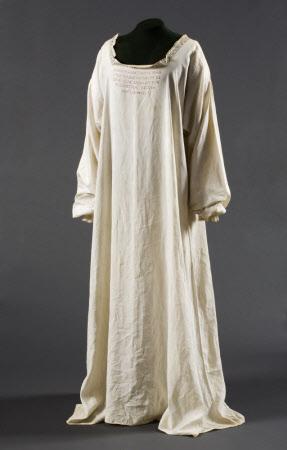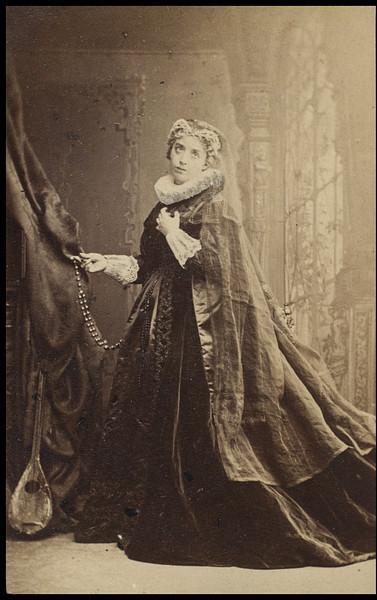
Photo: National Trust.
Chemise allegedly worn by Mary, Queen of Scots at her execution on the 8th of February, 1587. It is on display at Coughton Court, Warwickshire, the family seat of the loyal English Catholic family, the Throckmortons and has clearly been revered as something of a relic of the dead Queen.
I’m seeing a teeny tiny problem with this provenance though and I’m not just talking about the fact that Mary allegedly caused a ripple of sartorial admiration by choosing to strip down to a flame red chemise for the moment of execution…

My second favorite portrait of Mary. I’m still hunting for a picture of my favorite. I shall regale you all with it once I do though.
I’m not exactly Mary, Queen of Scots biggest fan but my grandparents ADORED her and I spent a considerable amount of my formative years being dragged around Scotland and Northern England to spots of varying degrees of obscurity that were associated with the tragic Scottish Queen. It was at Bolton Castle, scene of one of her imprisonments that I started my illicit collection of Small Stones Stolen From Historic Buildings, which I kept labelled in a box under my bed and which is now sadly lost. In this I was inspired partially by my own faintly anarchic spirit (ask my husband to tell you about my past issues with keeping the fake food in National Trust property kitchens from slipping into my pockets) and also by the reverence with which Mary Stuart’s many and various relics are treated. I must have seen enough rosaries belonging to Mary, Queen of Scots to furnish a whole Vatican’s worth of nuns and enough of her needlework to make a patchwork version of the Bayeux Tapestry twenty times over…

Now, I may not be Mary’s biggest fan but she has no need of me as she’s always had her loyal and devoted champions and I think I’m going to let one of the most ardent, a certain Miss Jane Austen have the last word today on the anniversary of her execution…
‘But oh! how blinded such Writers & such Readers must be to true Merit, to Merit despised, neglected & defamed, if they can persist in such opinions when they reflect that these Men, these boasted Men were such Scandals to their Country & their Sex as to allow & assist their Queen in confining for the space of nineteen Years, a Woman who if the claims of Relationship & Merit were of no avail, yet as a Queen & as one who condescended to place confidence in her, had every reason to expect Assistance & protection; and at length in allowing Elizabeth to bring this amiable Woman to an untimely, unmerited, and scandalous Death.
Can any one if he reflects but for a moment on this blot, this ever-lasting blot upon their Understanding & their Character, allow any praise to Lord Burleigh or Sir Francis Walsingham? Oh! what must this bewitching Princess whose only freind was then the Duke of Norfolk, and whose only ones are now Mr Whitaker, Mrs Lefroy, Mrs Knight & myself, who was abandoned by her Son, confined by her Cousin, abused, reproached & vilified by all, what must not her most noble mind have suffered when informed that Elizabeth had given orders for her Death! Yet she bore it with a most unshaken fortitude, firm in her mind; Constant in her Religion; & prepared herself to meet the cruel fate to which she was doomed, with a magnanimity that could alone proceed from conscious Innocence.
And yet could you Reader have beleived it possible that some hardened & zealous Protestants have even abused her for that Steadfastness in the Catholic Religion which reflected on her so much credit? But this is a striking proof of their narrow souls & prejudiced Judgements who accuse her. She was executed in the Great Hall at Fotheringay Castle (sacred Place!) on Wednesday the 8th of February — 1586 —— to the everlasting Reproach of Elizabeth, her Ministers, and of England in general. It may not be unnecessary before I entirely conclude my account of this ill-fated Queen, to observe that she had been accused of several crimes during the time of her reigning in Scotland, of which I now most seriously do assure my Reader that she was entirely innocent; having never been guilty of anything more than Imprudencies into which she was betrayed by the openness of her Heart, her Youth, & her Education.‘ — Jane Austen in her History of England, 1791.
